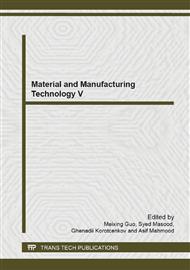p.152
p.157
p.162
p.169
p.174
p.179
p.183
p.188
p.195
The Influence of SS316L Foam Fabrication Parameter Using Powder Metallurgy Route
Abstract:
Metal foams are widely produced by using different techniques such as compaction and replication method. In this study, slurry method also known as replication method has been used to produce SS316L foams. SS316L powders (50wt% and 60wt%) were mixed with the binders and distilled water by using mechanical stirrer. Polyethylene Glycol (PEG) and Carboxyl Methyl Cellulose (CMC) were used as binders. Polyurethane (PU) foam was used as scaffold and dipped into SS316L slurry then dried in room temperature for 24 hours. Sintering process has been done in two different temperatures which were 1200°C and 1300°C in vacuum furnace. The morphological study was performed using Scanning Electron Microscopy (SEM) and Energy Dispersive X-Ray (EDX). The SEM micrograph showed that the cells were interconnected and the structures become denser as the sintering temperature increase. The average pores size is ranging from 252.8 μm-353.8 μm, while strut size ranging from 50.2 μm-79.9 μm based on SEM micrograph analysis. The elemental analysis from EDX showed the element presence in the SS316L foam remain from SS316L powder which are Chromium (Cr), Nickel (Ni), Molybdenum (Mo), Cooper (Cu), Nitrogen (N2), Sulphur (S) and Silicon (Si). Higher sintering temperature contributes better grain growth between particles where the point-contact between the particles expanded and disappear the small pores.
Info:
Periodical:
Pages:
174-178
Citation:
Online since:
June 2014
Authors:
Keywords:
Price:
Сopyright:
© 2014 Trans Tech Publications Ltd. All Rights Reserved
Share:
Citation:


